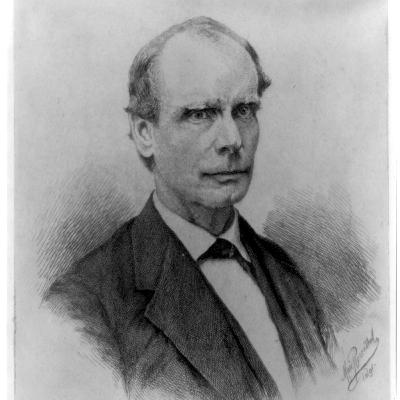Discover Walter Edgar's Journal
Walter Edgar's Journal

Walter Edgar's Journal
Author: South Carolina Public Radio
Subscribed: 209Played: 14,772Subscribe
Share
© 2024 South Carolina Public Radio
Description
From books to barbecue, and current events to Colonial history, historian and author Walter Edgar delves into the arts, culture, and history of South Carolina and the American South. Produced by South Carolina Public Radio.
345 Episodes
Reverse
Today our guest is Mt. Pleasant native Grady Hendrix, author of the horror novel Witchcraft for Wayward Girls (2025, Berkley Books). The novel is set in Florida in 1970 and is about a group of pregnant teenage girls, living in a maternity home for unwed girls, who discover a book on witchcraft. For the first time in their lives power seems to be in the hands.We’ll talk with Grady about this latest book, as well as some of his past one, and explore how he came to specialize in the horror fiction genre.
This week we'll be talking with Dr. Jennifer Whitmer Taylor of Duquesne University about her book, Rebirth: Creating the Museum of the Reconstruction Era and the Future of the House Museum (2025, University of SC Press).In Rebirth, Taylor provides a compelling account of how to reenvision the historic house museum. Using the Museum of the Reconstruction Era—known as the Woodrow Wilson Family Home for most of its many years as a house museum—as a case study, Taylor explores the challenges and possibilities that face public history practitioners and museum professionals who provide complex interpretations of contested public memory. Anchored by oral history interviews with docents who interact directly with the visiting public, Rebirth considers how a dated and seemingly outmoded venue for interpretation, the historic house museum, can be reimagined for twenty-first-century audiences.
This week Walter will be talking with documentary filmmaker Ken Burns about the American Revolution, focusing on the routing of the British and their allies by revolutionary Partisans during Cornwallis’ Southern campaign. Ken will also tell us a bit about his upcoming PBS documentary, The American Revolution. The six-part, 12-hour documentary series explores the country’s founding struggle and its eight-year War for Independence.This much-anticipated series will premiere on Sunday, November 16, and will air for six consecutive nights, from 8:00 to 10:00 p.m. on PBS and SCETV. The full series will be available to stream beginning Sunday, November 16 at PBS.org and on the PBS App.
Today we’ll be switching things up a bit. Instead of Walter and Alfred interviewing a guest we will have a guest interviewing Walter.The conversation is part of the Spring 2025 program put on by the University South Caroliniana Society: “E is for Edgar – Conversation and Barbeque with Walter.” Talking with Walter today is Beryl Dakers, president of the Society and long-time producer with SCETV.
In his book Grant’s Enforcer: Taking Down the Klan Guy Gugliota offers a gripping story of the early years after the Civil War and the campaign led by President Ulysses S. Grant’s attorney general Amos T. Akerman to destroy the Ku Klux Klan. Akerman, a former Georgia slaveholder and the only Southerner to serve in a Reconstruction cabinet, was the first federal lawman to propose using the Fourteenth Amendment to prosecute civil rights violations.Gugliotta uses newspapers, documents, and first-person stories, including thousands of pages of testimony under oath taken by a Congressional joint committee tasked in 1871 to study the Ku Klux Klan, a breathtaking compilation of accounts by Ku Klux targets, their attackers, local and national politicians, public officials and private citizens. The result is a vivid portrait of the Reconstruction South through the career of this surprising man.Guy joins us in conversation this week to talk about how Grant and Akerman took down the Klan.
This week we’ll be talking with Dr. Kathleen DuVal about native Americans in Colonial South Carolina.Long before the colonization of North America, Indigenous Americans built diverse civilizations and adapted to a changing world in ways that reverberated globally. And, as Kathleen will tell us, North American civilization did not come to a halt because of a few wandering explorers, even when the strangers came well-armed. Much of our discussion today is based on Kathleen DuVal’s Pulitzer Prize-winning book Native Nations: A Millennium in North America.
This fall we are celebrating 25 years of Walter Edgar’s Journal!We thought that a good way to start that celebration would be to look back on the launch of our podcast. So, this week we bring you an encore of our final *broadcast* episode of May 2023.Our guest was the Director of SC Public Radio, Sean Birch. We reminisced about the Journal’s beginnings and present highlights from our years on the air. And we talked about how morphing Walter Edgar’s Journal from a weekly broadcast into a semi-monthly podcast would allow us to focus more intently on our mission to explore South Carolina’s history and its culture.
This week we’ll be talking with Nic Butler, the historian at the Charleston County Public Library. He has been digging into archives both here and in Britain, researching the life of George Anson. Anson, was an officer in the British Navy who, by the time of his death in 1762, had risen to its highest rank, First Lord of the Admiralty. He had also spent 9 years in South Carolina during its time of transition from a colony governed by the Lords Proprietors to a colony of the British Crown.That change wasn’t instant and some of the history the colony's governance during the transition - as well as that of day-to-day life – are sometimes unclear. However, in researching George Anson, Nic Butler has both found a valuable through-line to this history and shone a light on Anson’s own fascinating story.
This week we’ll be talking with Dr. Henry N. Tisdale, former president of Claflin University in Orangeburg, South Carolina. This Kingstree native has had a long and distinguished academic career, earning his undergraduate degree at Claflin in 1965 and, eventually, becoming the first African American to earn a doctorate in mathematics from Dartmouth. His career path led him into college administration, and he became Claflin University’s president in 1994.Claflin, like many historically black colleges and universities at the time, was struggling – facing declining enrollment and possible loss of accreditation. Henry Tisdale established the goal that Claflin would “enter the 21st century with an eye to become a premier liberal arts institution.” Thanks in large part to his leadership, Claflin was named the number one HBCU by Forbes magazine and was ranked in the top 4% of U.S. colleges and universities. Tisdale tells the story of Claflin’s renaissance in his book, Beyond the Western Wall: Audacious Transformation of a Small Liberal Arts College (2025, Cecil Williams Photography/Publishing).
This week we are going to be exploring South Carolina from A to Z. That’s the title of our sister podcast from which we will select topics that deserve a longer look that just 60 seconds.This time out we'll discuss the ambitious man whose name adorns a Christmas decoration; the aristocratic Royal Governor who just didn't "get" South Carolina; the once powerful leadership body in the colony that lost it's standing almost overnight; and the young, talented South Carolina legislature who had a real impact on our young republic as well as our state.
This time out we are bringing you an encore from our broadcast archive featuring a conversation with Ben Beard, author of The South Never Plays Itself: A Film Buff’s Journey Through the South on Screen (2020, UGA Press).Beard’s idiosyncratic narrative—part cultural history, part film criticism, part memoir—journeys through genres and eras, issues and regions, smash blockbusters and microbudget indies to explore America’s past and troubled present, seen through Hollywood’s distorting lens. In The South Never Plays Itself, Ben attempts to answer the question: what do movies know about the South that we don’t?
After two decades of research and investigation, the South Carolina Battleground Preservation Trust, in collaboration with the South Carolina American Revolution Sestercentennial Commission (SC250), has unveiled the first volume of the Francis Marion Papers, a project that holds the potential to reshape our understanding of one of the American Revolution’s most heroic figures.The papers, consisting of more than 600 historical documents, include letters written both to and from General Francis Marion, famously known as the Swamp Fox for his elusive guerrilla warfare tactics against British forces. These materials, discovered in archives across the country have been carefully compiled and annotated by leading historians. The first volume, complete with illustrations and battle maps, was released on February 27 – the anniversary of Marion’s death.For this episode we sat down with Molly Fortune, CEO of SC250); co-editor Ben Rubin, and co-editor Rick Wise, Director of the SC Battlefield Preservation Trust, to talk about the work behind the publication of the papers and about Marion and his compatriots in the Revoultionary War.
Few people beyond South Carolina’s Lowcountry knew of Emanuel African Methodist Episcopal Church in Charleston—Mother Emanuel—before the night of June 17, 2015, when a twenty-one-year-old white supremacist walked into Bible study and slaughtered the church’s charismatic pastor and eight worshippers.In his book Mother Emanuel: Two Centuries of Race, Resistance, and Forgiveness in One Charleston Church (2025, Crown) Pulitzer Prize–winning journalist Kevin Sack explores the inspiring history that brought the church to that moment, and the depth of the desecration committed in its fellowship hall.In this expanded episode of Walter Edgar's Journal Kevin joins us to explore the story of Emanuel A.M.E. Church in Charleston.
This week we will be talking Scott Romine, author of The Zombie Memes of Dixie (2024, UGA Press). The book traces the origin and development of several propositions, tropes, types, clichés, and ideas commonly associated with the U.S. South.Approaching these propositions as memes Scott argues that many of them developed in defense of slavery and evolved in its aftermath to continue to form a southern group whose “way of life” naturalized an emergent regime of segregation.
This week we're going to explore South Carolina from A to Z. Walter and Alfred will take five topics from past episodes of our companion podcast, South Carolina from A to Z, and discuss each at length, giving these people and events from our state's history some room to "breathe."We'll tell you about the man who founded the earliest European settlement - 1562 - in what is now South Carolina. We'll look at this history of a very important ingredient in South Carolina foodways. And, we'll learn about a singular, perceptive observer of the Confederate elite and whose writings add to our understanding of a tumultuous time in our history.
This week we'll be talking with Timmonsville native Johnny D. Boggs about his latest novel, Bloody Newton: The Town from Hell (2024, Psicom Publishing), his journey from a childhood in the Pee Dee, his life in Santa Fe, New Mexico,and his career as a celebrated author of Western fiction. Bloody Newton has just won for Johnny his tenth Spur Award from The Western Writers of America.
This week we going to explore South Carolina from A to Z. That’s the title of our sister podcast and the title tells you all you need to know about what that podcast does: Letter by letter Walter goes through the South Carolina Encyclopedia, giving you bite-sized takes on the history of the Palmetto State. The challenge he faces for each episode is that it is only one minute long - 145 to 149 words of text to cover the topic.On today's Journal Walter and Alfred are taking five topics from past editions of South Carolina from A to Z and are discussing each at lenght, giving some of these people and events from our state's history room to "breathe."
This week author and journalist Carolyn Click joins us to talk about her new book, The Cost of the Vote: George Elmore and the Battle for the Ballot (2025, USC Press). Elmore's story is that of a man who believed, with uncommon boldness, that he and other Black Americans were guaranteed the right to vote. He volunteered to become the plaintiff in the NAACP lawsuit that successfully challenged the all-white Democratic primary in South Carolina in 1946.Carolyn centers her story on Elmore, his family, his neighbors, and the activists and lawyers who filed the suit. Although Elmore's court challenge would prove successful, he and his family paid a steep personal price.
This week we'll be talking with Andrew Waters about his latest book, Backcountry War: The Rise of Francis Marion, Banastre Tarleton, and Thomas Sumter (2024, Westholme Publishing). In it Andrew weaves the history of three key leaders in the American Revolution into in a single narrative, focusing on the events of 1780 in South Carolina that witnessed their collective ascendance from common soldiers to American legends. It was a time when British victories at Charleston and Camden left the Continental Army in tatters and the entire American South vulnerable to British conquest. Yet in those dark hours, Sumter, Marion, and others like them rose in the swamps and hills of the South Carolina wilderness. Their collective efforts led to the stunning American victory at Cowpens and a stalemate at Guilford’s Courthouse the following year that finally convinced British general Charles Cornwallis to abandon the Carolinas for Virginia and eventually to Yorktown where his beleaguered army surrendered.
This week, we’ll be talking with Bennett Parten, author of Somewhere Toward Freedom: Sherman's March and the Story of America's Largest Emancipation (2025, Simon & Schuster).In Somewhere Toward Freedom, Ben reframes this seminal episode in Civil War history. He not only helps us understand how Sherman’s March impacted the war, and what it meant to the enslaved, but also reveals how it laid the foundation for the fledging efforts of Reconstruction.Sherman’s March has remained controversial to this day. Ben Parten helps us understand not just how the March affected the outcome of the Civil War, but also what it meant to the enslaved—and he reveals how the March laid the foundation for the fledging efforts of Reconstruction.s














